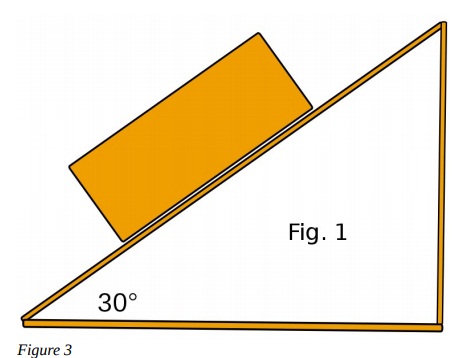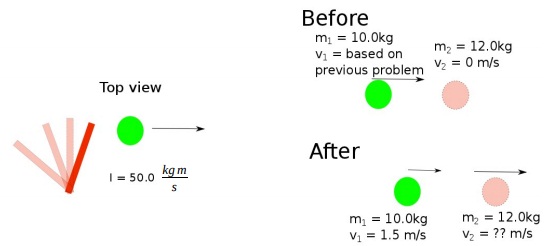Assignment:
1. What is the potential energy of the ball at part I (see figure 1) if the following is true: A 25.0 kg ball rolls off a 3.0 meter, frictionless ramp, inclined at 30.0º onto a level, frictionless floor for 25.5 seconds. Then it rolls up another frictionless ramp of equal degree and 3.5 meters in length. What is the kinetic energy of the ball at the part I/part II boundary? What is the work done in part I and in part II? What is the total work done on the system from start to finish?
What kind of potential energy is described in part I? If the 2nd ramp in part III were only 2.5 m, at what velocity (remember, speed and direction) will the ball leave the ramp? Now, take a 25.0 kg ball that rolls along a flat, frictionless surface, and has to reach the end of the 5.5 meter frictionless ramp elevated 1.5 meters (part II to part III in figure 2).
What is the angle made with the horizontal (i.e. At what angle is the ramp tilled)? What is the needed velocity to go up the ramp? When the ball stops at the end of the ramp, what is its potential energy? What is the total work done on the system from part II to part III? Does this system represent conservative or non-conservative forces?

2. A brick is on 30.0° incline (fig 3). Draw the Free Body Diagram. What is the net force on the brick if it is stationary? What must the coefficient of static friction (µs) be to have zero net work done on the block? If the block is 125 kg, what is the work done by gravity, by friction and the net work on the block if it slides down for 5.0 seconds and assuming µk to be 1/8 that of µs? Starting at rest on a flat, frictionless surface, calculate the acceleration needed to attain the same amount of work as the system above over a 10.5 second period.

3. Each object, starting from left to right, has a mass of 20.0 kg, 25.0 kg and 5.0 kg respectively. They are attached by rope and pulled by an individual (see figure 4). Their unified acceleration is 5.5 m/s2 in the x direction. What is the horizontal force applied on the block system? What type of horizontal force is applied on all three blocks (e.g. tensional, compressional, etc)?
What is the horizontal force applied on m3? What is the work done by all the blocks if they all start from rest, and are accelerated with the force you calculated for 10.0 seconds? If 220.0 N frictional force is applied to the system, will the system continue to accelerate? If so, by how much? Explain your reasoning.

4. What is the acceleration needed for the ball, initially at rest, to achieve an impulse of 50.0 kgm s in 1/10 of a second (ball is hit by a bat) if the mass of the ball is 10.0 kg? What was the force applied? What was the ball's acceleration? This ball, now traveling with a final velocity gained from the previous problem, strikes head on a stationary 12.0 kg ball, the result slows the striking ball down to 1.5 m/s (see figure 6). What is the other ball's velocity after the collision? What type of collisions is this?

Medical Mechanics Section
5. Calculate the strain and the stress of the mean length of both a male and female femur bone when compressed by 1.2x10-4 m. How much heat is generated in the bone when this occurs? How does this relate to the conservation of energy? Explain what kind of activity could yield such a strain in the bone.
6. The common femoral vein (CFV) mean diameter is around 11.00 mm, and blood flow velocity generally around 13.0 cm/sec. Assuming steady blood flow from the CFV, calculate the velocity change of blood flow from the CFV into another vein 10.0% less wide. Assuming a 0.01 mL of blood in the vein and using the average density of blood for a healthy individual, calculate the work done on blood traveling from one vein to another. Assuming that the displacement of blood in transition from one vein to the other is 0.01mm, estimate the blood pressure going into the smaller vein. What would be the density of blood in the smaller vein needed such that it has the same blood flow speed as in the CFV?
7. Be sure to sketch this problem! A leg of 15.0 kg and 0.75 m in length is lifted off the edge of a bed by two cables; one hanging at 30.0° and the other at 60.0°. Calculate the tensions in the cables. Continuing on, when measured from the foot, the leg is 0.50 m from the floor and makes a 15.0° from the bed level (the patient is sitting at the edge of the bed). Assuming that most of the leg's mass is focused on the foot and the mass in the leg is negligible, what would be the gravitational potential energy of the foot measured from the floor? What is the moment of inertia of the leg (again, for simplicity, assuming the mass to be focused at the foot location)?
If the leg were released from the cables suddenly, how much rotational kinetic energy will the foot gain when it finally rest at the edge of the bed? What would be the maximum angular velocity of the foot as it swings down to the side of the bed? Calculate the torque that the footleg system undergoes?
8. What occurs to the blood vessels when a healthy persons continues to increase their elevation, such as driving through a mountainous region? Explain in detail, using illustrations and such. Explain what would happen if someone is suffering from arteriosclerosis and drives up said hill? Explain in detail, using physics as your guide.
9. Explain how Newton's Laws are applied throughout what you have learned thus far, in particular to any discipline in medicine. Explain in detail, a well as cite examples.